Self is the essential being of a person. Art is a mirror image of a person’s identity, circle of influence, and perceived worlds or realities. Art reflects what we feel, think, practice, believe, or imagine. Season 1 of Art:21 introduced several artists who explore identity in their work. The documentary on Identity addressed how contemporary artists reveal and question commonly held assumptions about stereotypes, self-awareness, portraiture, and what it means to be an artist. This is based on how identity is constructed in the tangible world, but what about the virtual 3D world?
In virtual 3D worlds, artists release conceptions of self and extend perceptions of self beyond real life, material, superficial, or traditional ideas. The 3D avatar represents the human or a fantasy-based representation of a person’s self that can constantly be altered or changed. Artists explore these representations in their work, often using their avatar as art, or as part of an artwork, adding to it, or using it to perform. In Performative Interventions, I included a few examples of artists who see immersion as a means of taking their virtual performances directly to a global audience.
In keeping with previous posts regarding Dr. Gary Zabel’s “aesthetic-technological dimensions” of art in virtual 3D worlds, I pulled his text on ambiguity of identity. He writes:
Ambiguity of identity results from the fact that our bodily presence in the virtual world is mediated by a digital representation. All dwelling within a world involves being present in a body which both constitutes our perspective on things and makes us present to other embodied experiencers. Though personal identity can be a very complex construction, its ultimate foundation is continuity of bodily presence. However digital bodies, and the names that uniquely identify them, can be altered, multiplied, discarded, or exchanged at the will of the user. Since bodily presence is open to such radical discontinuity, the identity of the virtual person is protean and ambiguous, including indicators of age, gender, race, and even biological species.
When I first met Artistide Despres in Second Life, her avatar was entirely blue in color. She told me it was a holdover from a previous collaboration with Pete Jiminy. Artistide is a real life artist and teacher of photography and new art technologies. She resides in The Netherlands and came to Second Life expecting to use it as a tool for teaching and learning. She is also actively involved with the Caerleon sims art collective. I met Artistide at her virtual studio in SL.
Here’s a transcript from a portion of our chat:
Nettrice Gaskins: I happened upon your virtual studio by accident yesterday but was already aware of your work. What brought you here?
Artistide Despres: Well, SL represents for me a sort of ideal, a place where people would be able to communicate, create art, without many fences: place, race, sex, appearance, etc., as only a communication between mental avatars. I think this is quite utopist. Concerning my work as a photographer reality was always taking a huge place in my creations and SL forced me to work with other concepts.
NG: What is the significance of the zeroes and ones? What do the numbers represent on some of your 3D objects?
AD: Well, the 0s and 1s refer to the way our identity is kept on registers. Also for the tag cloud image above us, I added more than 300 texts referring to identity. Then I made statistics about the most important words and this is the result. I expected to make my own choice of text quite nihilistic with the large number I collected.
NG: Impressive!
AD: My work is 70% research. My research can go in many directions and I try to integrate the result with my ideas, especially here at my studio.
NG: I noticed that your avatar is in a lot of your work. You/your avatar is a character through which you create art?
AD: Yes, definitively. We had discussion about identity within the collaboration (Caerleon sims) and one thing I didn’t agree with was the fact that a lot of people were trying to be their avatar on SL. My avatar is more a tool to achieve what I want in my creations.
NG: Is there a definitive work of yours that explores identity as a theme?
AD: Not yet. I am planning to participate in a collaboration that will exhibit in June. I’m still brainstorming about that. I also like to create in symbiosis with the environment that will be used by the group of creators, so I really need the final place. I hope my contribution will have a political or suggestive color.
NG: I’ll definitely look out for it.
[youtube:https://www.youtube.com/watch?v=2H1Fp3hGhiM]
Another project to look out for is The Gracie Kendal Project: A Conversation with My Avatar, a mixed-reality collaboration between real life artist Kris Schomaker and Gracie Kendal, her avatar in Second Life.
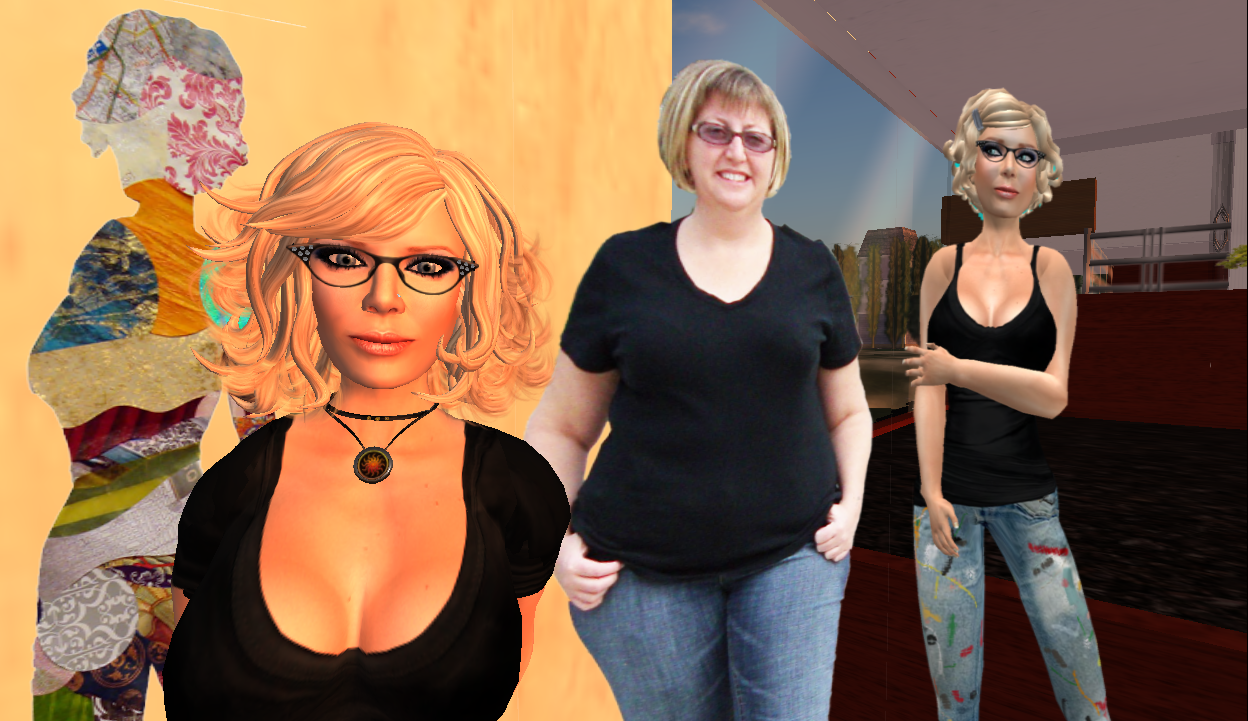
Gracie Kendall, "Faces of Gracie." Photo by Rowan Derryth, 2009. © All rights reserved.
Gracie Kendal AKA Kris Schomaker has been exhibiting her paintings in SL for a while now and The Gracie Kendal Project has already created some media buzz. I’m including it here because of its connection to the theme of identity, or the transformational aspects of the virtual identity and how these aspects influence real life perceptions of self.
[youtube:https://www.youtube.com/watch?v=CrLItEtAj3g]
The Gracie Kendal Project addresses the artist’s personal interest in self-exploration and finding herself. This virtual 3D self-portraiture is part of a process to help the real life artist (Kris) learn how to bravely accept her physical, tangible self. Gracie/Kris employed several virtual 3D incarnations of herself in a series of performances as part of her Masters art thesis. This project is reminiscent of the Ten Avatars of Vishnu and the history of the avatar in ancient Hindu art.
Diogenes Wylder AKA Georgie Roxby-Smith (in real life) is an Australian artist currently in New York to complete a residency and mixed reality performance at the Watermill Center. She uses Second Life to deconstruct layers of reality and fragment identity through both in-world work and through recreations in real life. Diogenes writes,
By creating an avatar – self-portrait or otherwise – we create a strange balance between the level of investment and exposure of ourselves and role-play. I am compelled by the general use of the “idealised body” by many users of Second Life and the desire to create utopian selves and environments in their blandest possible form. Avatars are hollow – avatars are pure, avatars are clean, avatars have no orifices. They do not leak, sweat, smell – there is no inconvenience to their bodies. In exploring these ideas, I extract my self-portrait avatar, Diogenes Wylder, from the screen, re-enacting her movements, wants, and needs in a distorted and grotesque version of herself (in what has been referred to as eccentric figuration).
Diogenes/Georgie aims to fracture the self / performer / avatar through multiple reproductions including:
- The real artist as performer;
- The self-portrait avatar Diogenes Wylder;
- Multiple representations of the avatar operated by Second Life performers, real life performers and audience members in the Watermill space in avatar costume;
- Second Life avatars (in-world) to be given a Diogenes Wylder avatar skin; and
- A mannequin representation of the avatar in the material performance space also replicated in the Second Life as a “bot.”
In this way, not only the self will be fractured but also the position and role of the audience who are at once caught between realities, identities and their roles as spectator or performer/actor.
[youtube:https://www.youtube.com/watch?v=-bBQdOEmrnk]
The Ars Virtua Gallery is currently looking for works that “challenge our ideas, exemplifies our ideals, exposes our struggles and represents our racial identity within virtual spaces.” By the time of this blog posting, the submission deadline will have passed. However, the show will open in May 2010. The website poses interesting questions related to the issue of race in virtual 3D worlds:
The idea of race has evolved over time. It is not just about color, it is about who we are.
How is race of the puppeteer relevant to the avatar? Where are all the people in Second Life? It seems that we travel in a bubble of similarity.
Some struggle to keep a distinction between their identity and their avatar, but is even that possible? Can you separate your gender, race and culture from your online persona? The avatar is nothing but a shell waiting to be filled by personality, thoughts and actions.
Do we gravitate to people of the same cultural background in virtual environments?
I am very interested and intrigued by these questions. It brought to my mind a real-life art installation at the Hirshhorn Museum in Washington, D.C. in 1994. Conceptual artist Glenn Ligon stenciled four quotes from a Zora Neale Hurston essay, how it feels to be colored me, directly on the walls:
I feel most colored when I am thrown against a sharp white background,
I remember the very day that I became colored,
I am not tragically colored, and
I do not always feel colored.
Ligon and Hurston were exploring the idea of race as a concept that is structured by context rather than essence. What would happen if in Second Life or another virtual 3D world, human-driven avatars were immersed in the Ligon/Hurston construct of race? What happens when people, embodied as avatars, are thrown against different backgrounds and then asked to dialogue about it? Maybe this blog is the place for exploring these questions. Maybe the virtual 3D world is the better place for a discourse. In the meantime, we can experience the art.
In the Sweet Bye & Bye: An Immersive Memoir was created in Second Life by Jacque Quijote AKA Phillip Mallory Jones, with text by his mother, Dorothy Mallory Jones. The project is an artistic collaboration of mother and son; a personal expression of family stories and pictures, woven with threads of haunting images from the past. Dorothy Mallory Jones’ poetry celebrates black womanhood and family. Philip Mallory Jones is from the South Side of Chicago and like his mother, is both a storyteller and artist. His work has been widely recognized and exhibited including by the Caerleon sims art collective.
In the Sweet Bye & Bye is a dodecahedron-shaped container with 12 sides that requires the avatar enter the space using the mouselook feature in Second Life. Mouselook allows the viewer to see the art from a first-person perspective — “through the avatar’s eyes.” The keyboard is still used to move the avatar, but the mouse is used to look around. Inside of the space are opaque and semi-opaque panels created using flexible 3D objects with images and text applied as textures. The panels include many personal, cultural, and spiritual references.
The opportunities for opening up a dialogue and building bridges across divisions using virtual 3D worlds are vast. Artists, like the ones featured here, have just begun exploring ways to define self and identity through emotive, performative, spiritual, and cultural narratives. Does semi- or total anonymity and ambiguity of identity create the safety required to delve deeper into self or address provocative/political issues that often drive people a part in real life? Can the aesthetic-technological dimensions in virtual 3D worlds forge new inroads for social change? If so, then how? I have my own thoughts but I’d love to read and respond to other points of view.

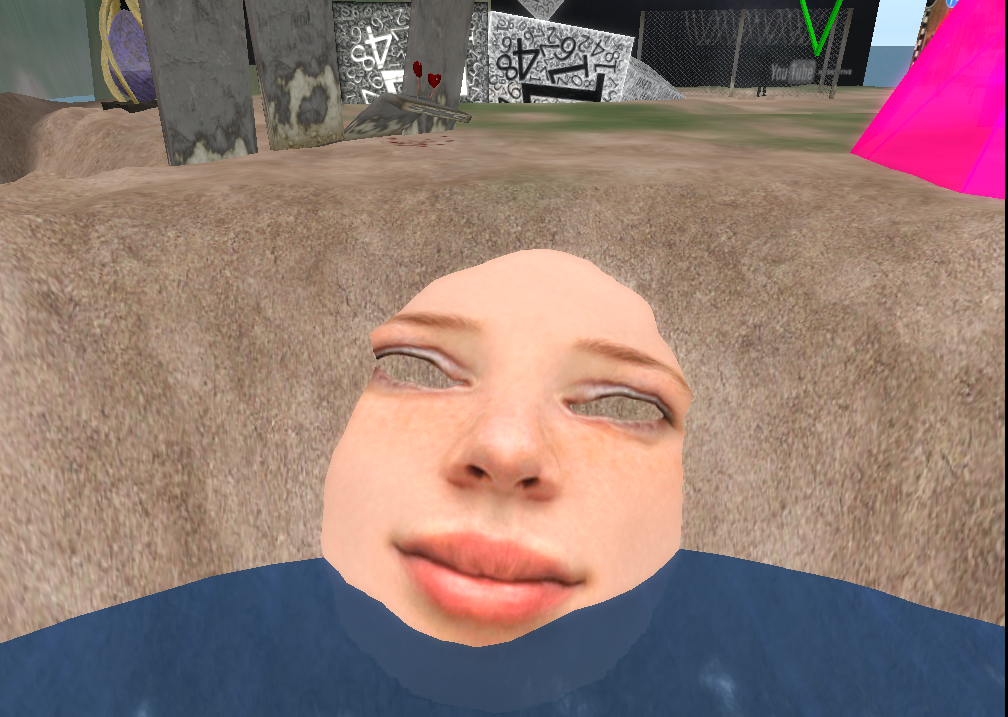
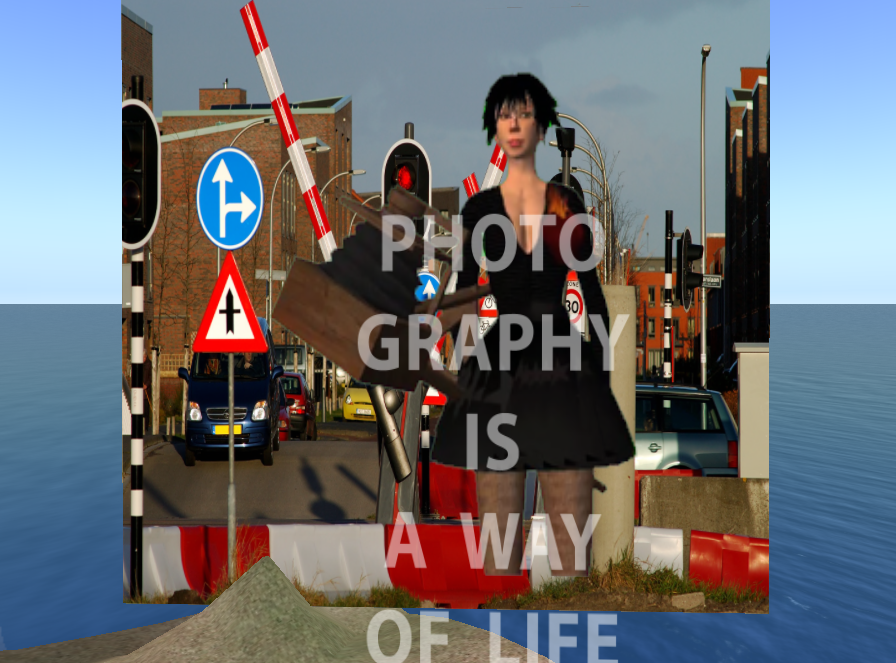
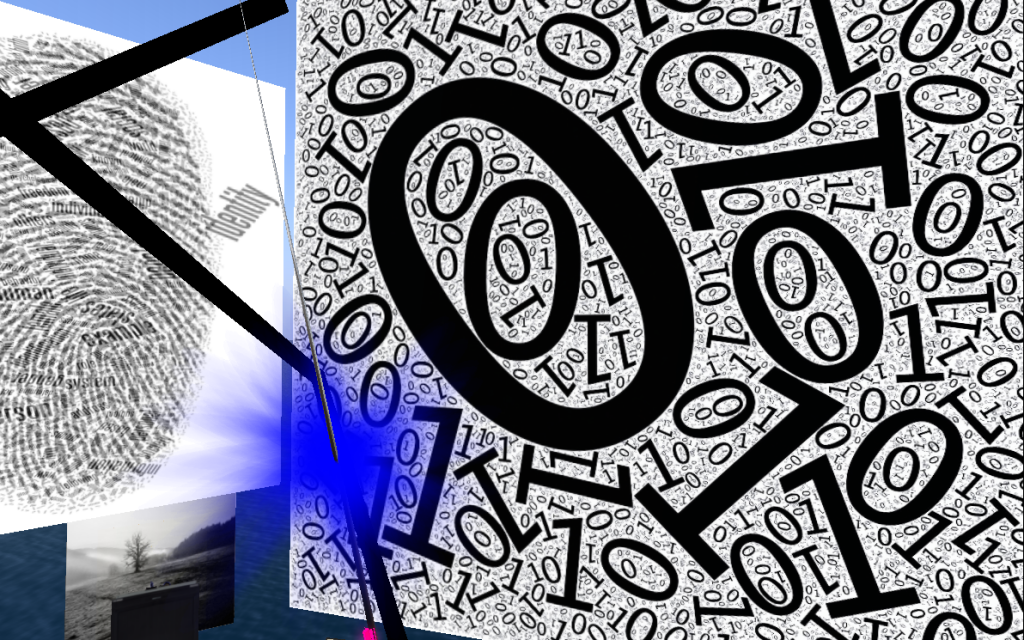
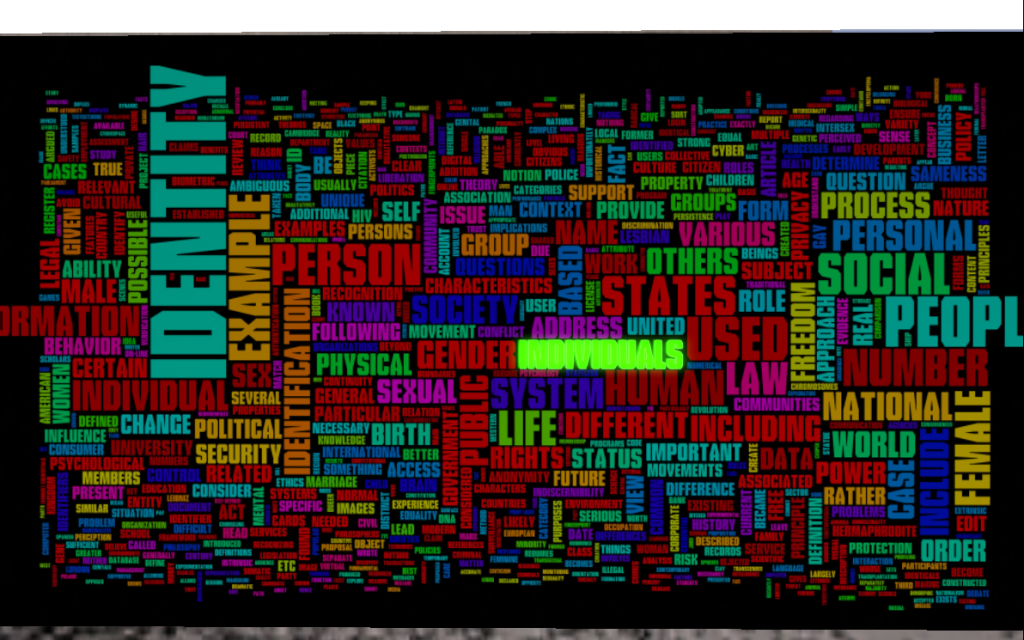
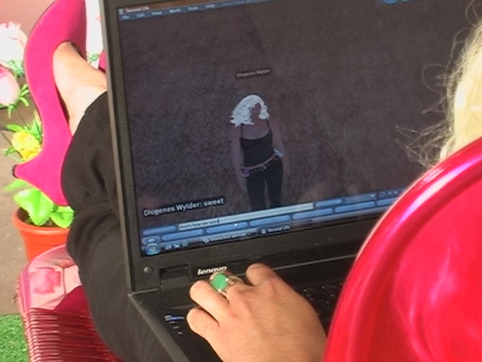
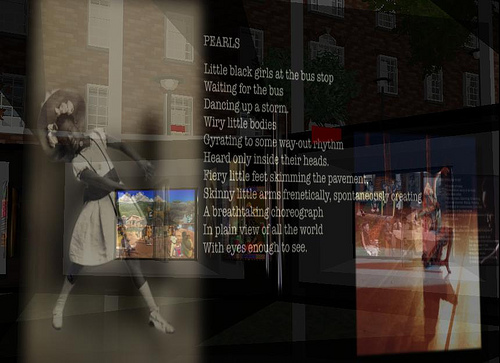
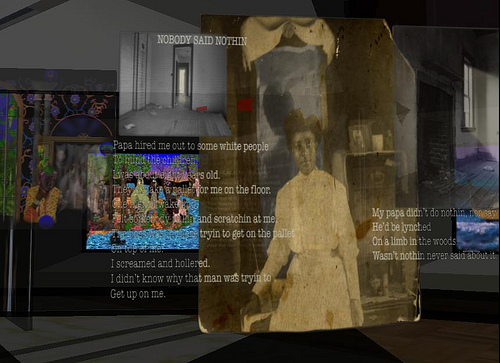



Pingback: Beyond Boundaries: Art Exhibition & Virtual 3D Worlds | Art21 Blog
Pingback: » Identity 3.0
Pingback: Transhumanism in the Hyperreal « SL Art HUD Blog Thingie:
Pingback: Art 2.1 | New Frontier at Sundance 2013: 4D Art and Augmented Real | Art21 Blog
Pingback: Afrofuturism: Identity | Renegade Futurism